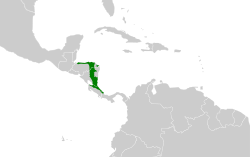| Snowy cotinga | |
|---|---|
 | |
| Scientific classification | |
| Kingdom: | Animalia |
| Phylum: | Chordata |
| Class: | Aves |
| Order: | Passeriformes |
| Family: | Cotingidae |
| Genus: | Carpodectes |
| Species: | C. nitidus |
| Binomial name | |
| Carpodectes nitidus Salvin, 1865 | |
 | |
The snowy cotinga (Carpodectes nitidus) is a medium-sized species of passerine bird in the family Cotingidae. It is found in Costa Rica, Honduras, Nicaragua, and Panama. [2]

